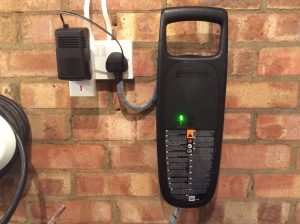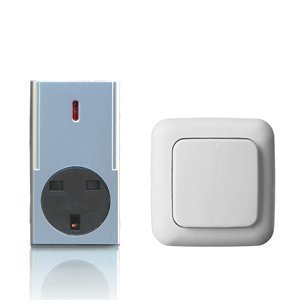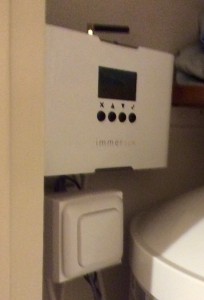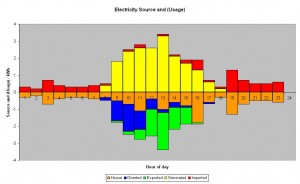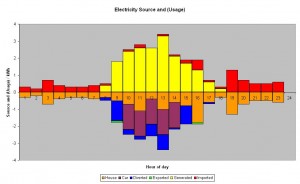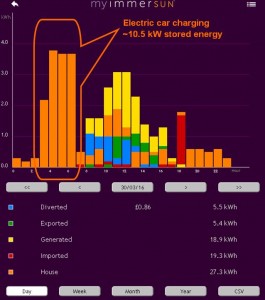Well, with a bit of tinkering, my solar car charger is working with the charger turning on automatically when the output from the solar panels is sufficient, but I already have in mind a few improvements.
- As it stands the system turns off as expected when household demand rises, such as when boiling a kettle, but it takes some time for charging to restart after the signal is sent, presumably down to some logic in the charging equipment. I’d prefer something a bit less dynamic in responding to short term demand changes, but that restarted sooner.
- The signal from the ImmerSUN tends to turn off too quickly to my mind as, having turn on a relatively big load, it decides there isn’t enough capacity to run a big load. The logic effectively determines that there isn’t enough spare capacity to turn on the load a second time, turns off the load, and then decides that there is enough capacity. To my mind this just cycles the power unnecessarily and, with the delays in restarting already reported, also reduces total energy transfer.
Consequently I’m already working on improvements:
- Firstly I’m changing the protocol controller than coordinates the handshake with the vehicle. The new one should enable a more rapid restart after interruption without the uncertainties of the delays in the OEM controller. It will also provide an alternative mechanism to stop charging. Instead of suggesting to the vehicle that the cable is about to be disconnected, the new one allows more direct control of the current by resistor selection – or turning on/off via a contact across the resistor.
- Secondly I’m upgrading to variable current rather than a simple on/off at low current. The new protocol controller documents maximum current choice by resistor selection, but I think that I’ve worked out how to provide infinitely variable current via an analogue voltage. The car will respond to the infinitely variable signal by drawing the highest compatible current from 0, 6, 10 and 14 Amps.
- Thirdly I’m reconfiguring the output of the ImmerSUN to be more dynamic, but then..
- Finally I’m building a module to sit between the transmitter receiver and the protocol controller. The new module will set upper and lower current limits and set the ramp rate / time constant for the system response.
My intention is that the result of this is that in response to a jump in available power the controller will slowly ramp up the output to meet the availability and then slightly cycle the analogue output as the ImmerSUN output cycles on and off. The vehicle will respond by cycling between the currents immediately above and immediately below the available current. As an alternative strategy it can be configured to cycle just below the available power, and thus theoretically not import any power from the grid, at the expense of not fully using the available solar power.
Which ever strategy is used the more highly dynamic water heating will continue to mop up any available power between what the vehicle takes and what’s available from PV.

